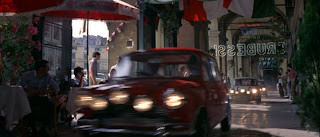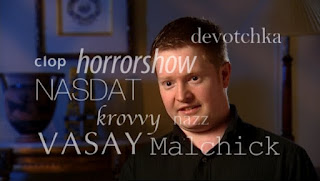‘The Spy Who Loved Me’ is the first Bond movie that has absolutely nothing to do with its source novel apart from the title. Coming late in the 007 canon, Fleming’s novel is something of an experimental work, narrated by the heroine and with Bond himself not showing up till a good half way through. Oh, and it’s set principally at a motor court in the middle of nowhere. Not the stuff that block-busting action cinema is made of.
It’s also the first hyper-budgeted Bond movie. From ‘Thunderball’ in 1965 to ‘The Man with the Golden Gun’ in 1974, the productions had generally cost between $7million and $9million. ‘The Spy Who Loved Me’, released in 1977, cost $14million. Although given that your average Bond movie, by then, was enjoying ticket sales of $100million plus, it wasn’t really that much of a gamble for the producers.
The enhanced budget was mainly due to the sets – another epic of bad guy kitsch courtesy of Ken Adam, of which more later.
The three year gap between the film and its predecessor was due to a series of production difficulties. Firstly, the partnership between Albert R Broccoli and Harry Saltzman came to an end. Saltzman sold his half of the partnership to offset financial difficulties; at the same time, his wife was diagnosed with terminal cancer. Battling depression, Saltzman all but retired from the movie business. He made only two returns to producing, with ‘Nijinsky’ in 1980 and ‘Time of the Gypsies’ in 1988.
The script was arrived at but a circuitous route. Broccoli, perhaps trying to emulate Roald Dahl’s iconoclastic work on ‘You Only Live Twice’, approached writers as diverse as Stirling Silliphant, Gerry Anderson (yes,
that Gerry Anderson), John Landis, Derek Marlowe and Anthony Burgess. (The thought of Burgess, in ‘Clockwork Orange’ mode, penning a Bond movie is priceless:
007: What’s it to be then, sir?
M: This malchick Stromberg is hatching some like cally sort of plan.
007: You want me to tolchock the starry-eyed old veck, sir?
M: I want you give it to him in the yarbles, 007, if he’s got any yarbles. Now get off and viddy what Q’s got for you.
007: Lovely lovely gadgets to slooshy the old ultra-violence with, sir?
M: Quite so, 007. Viddy well.)
In the end, it was series regular Richard Maibaum who was called upon to provide the screenplay. His first draft opened with the intriguing concept of SPECTRE overrun by a rival terrorist organisation and Blofeld ousted. Kevin McClory (remember him from the ‘Thunderball’ saga?) got to hear of this and threatened legal action. The SPECTRE angle was dropped. By now, the production had a director attached – Lewis Gilbert, returning for the second of his three Bond movies – who brought writer Christopher Wood on board. The script, shorn of all references to SPECTRE and Blofeld, and with oceanographer Karl Stromberg as Bond’s antagonist was finally credited to Maibaum and Wood.
Gilbert was contracted after Guy Hamilton turned the film down – he’d been offered ‘Superman’; in what must have been the most galling moment in his career, he was then passed over in favour of Richard Donner. Broccoli also considered Steven Spielberg, but decided to hang fire and see whether ‘Jaws’ did any real business at the box office. We’ll move politely on and let hindsight be the judge of that one.
Onto the story: in what is essentially a rehash of ‘You Only Live Twice’, but with submarines instead of rockets, naval vessels are being mysteriously hijacked, and when a British sub with a couple of Polaris missiles is captured, M (Bernard Lee) gets Bond (Roger Moore) on the case. In Russia, M’s opposite number General Gogol (Walter Gotell) gives
his best agent – Triple X, a.k.a Major Anya Amasova (Barbara Bach) – a similar brief.
The only clue either agent has is the appearance on the black market of the plans to the tracking system from one of the submarines, which is being auctioned by Egyptian club owner Max Kalda (Vernon Dobtcheff). Working initially in competition, then – reluctantly – in collaboration, Bond and Anya tangle with a seven-foot steel-toothed slab of anti-social behaviour named Jaws (Richard Kiel), finally get their hands on the plans and discover another clue that points them towards the reclusive Stromberg (Curt Jurgens) and his research facility in Sardinia.
The plot is a join-the-dots exercise in sending Bond to as many exotic locations as possible, and the central conceit – as mentioned before – is a rehash of ‘You Only Live Twice’, right down to Ken Adams’ set for Stromberg’s submarine base with its monorail and its upper level control station. When Adams voiced to Broccoli his concerns that there wasn’t a soundstage, at any studio in the world, big enough to incorporate the sets he’d envisaged, the producer’s response was: “Then build it one.” The result was the 007 stage at Pinewood.
The finale, in which Bond frees a group of incarcerated submariners and leads them into battle against Stromberg’s troops, is – again – ‘You Only Live Twice’ with sailors instead of ninjas. Additionally, there’s a hand-to-hand fight in a cramped train compartment – which had already been done twice: in ‘From Russia with Love’ and ‘Live and Let Die’. The gadgets are more outlandish, and while there’s nothing as awful as the flying car in ‘The Man with the Golden Gun’, the Lotus that turns into a mini-sub comes pretty close.

‘The Spy Who Loves Me’ also marks the point at which the franchise became entrenched in an infantile mindset that would dog the films for another decade. Case in point: the pre-credits sequence. M, concerned over the missing sub business, buzzes Moneypenny (Lois Maxwell) on the intercom and demands, “Where’s 007?” “On a mission, sir, in Austria,” Moneypenny replies. “Well, tell him to pull out,” snaps M. Cut to: Bond in log cabin making whoopee with a nameless bit of eye candy. A ticker-tape message scrolls out of Bond’s watch. He gets dressed and heads for the door. “But James,” protests the nameless bit of eye candy, “I need you.” “So does England,” Bond parries, and takes off on skis. Some gunmen are waiting for him. There’s a downhill chase laden with some dodgy back projection, then Bond skis off a precipice. He tumbles through the air, his skis detaching. A parachute flares out – in the colours of the Union Flag – and Bond floats to safety.
Double entrendres and in-yer-face jingoism. Whoop-de-fuckin’-doo.
There’s a deficiency in the villain department, too. While Jaws presents a threat by dint of his sheer physicality, Stromberg – for all that he wants to destroy the world in order to establish a new society under the sea – isn’t much of an antagonist. Portly and grey-haired, he looks less like a power-crazed sociopath than Dr No’s granddad.
In the Bond girl stakes, Major Anya Amarova suffers from Tiffany Case Syndrome: like Jill St John in ‘Diamonds Are Forever’, she spends the first half of the film being smart-mouthed and resourceful before the filmmakers decide to tug the leash and make her a simpering captive for the big finale, leaving all the tough guy stuff to Bond while she’s tied to a chair in an outfit that shows off her cleavage. (I can’t help but wonder how come Stromberg had that little number in his wardrobe.)
It doesn’t help, either, that Bach’s acting prowess is one-note. More infuriating is that B-movie goddesses Caroline Munro and Valerie Leon – both equally gorgeous and both better actresses – are relegated to minor roles (although, damn, Munro makes hers count!)


‘The Spy Who Loved Me’, for all that I’ve given it a bit of a kicking in this review, is a big improvement on ‘The Man with the Golden Gun’: it’s pacier, more exotic, a hell of a lot more fun to watch. But it seems to serve the same purpose in the Moore filmography that ‘Goldfinger’ does in the Connery canon. It fuses the elements that audiences identify with Bond movies – guns, girls, gadgets, globe-trotting and gratuitous one-liners – and, in defining the formula, emerges as an exercise in the formulaic. And, also like ‘Goldfinger’, it leaves me with mixed feelings: I like it a hell of a lot as a piece of mainstream entertainment, but it remains a paeon to the indulgences that mar the franchise rather than the elements that invigorate it.

























































































